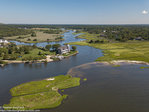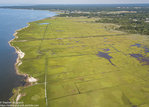

The L.I. Advance contacted the New York State Department of Environmental Conservation (DEC) to find out more information about State Environmental Conservation officials making an announcement that a $1.7 million marsh restoration project is underway at Fireplace Neck, a tidal wetland area near Bellport Bay in Brookhaven Hamlet. After decades of erosion, the much-needed project will replace flora which was destroyed over decades of coastal erosion. In addition, it will restore the 108-acre salt marsh’s environmental functions, including providing a safe habitat for marine life. The work, which is expected to be finished by April 2023, will necessitate the closure of Fireplace Neck to the public until that time.
LIA: When is the work on the salt marsh restoration project set to begin/end?
DEC: Construction began in 2022 and is expected to be completed in 2023.
LIA: How much will it cost? Who is funding it? Will it cost taxpayers?
DEC: Construction costs total $1.7 million and has been funded through New York’s Environmental Protection Fund (EPF) and Ocean and Great Lakes Fund, as well as U.S. Fish and Wildlife Services (USFWS) National Coastal Wetlands Conservation Grants program.
LIA: How long has this been needed and why? How did Hurricane Sandy contribute to this?
DEC: When it was first mapped by DEC around 1974, Fireplace Neck wetland was predominantly high marsh and upland adjacent area. Analysis in 2012 showed that the area is now majority intertidal marsh, with increasing pools of unvegetated open water, likely due to the manmade mosquito ditches that changed the natural hydrology of the site and reduced sediment deposition patterns. If the marsh were left, as it is now, DEC expects that erosion will continue, and intertidal marsh would convert to areas of open water and mud flats.
LIA: What will the project include?
DEC: First, the southern end of Mott Lane will be graded, and gravel added to allow machinery access. Then, three primary tidal channel outlets will be widened, and ditch plugs will be strategically removed and added to restore the movement of water through tidal channels and across the marsh. Micro-pools will be excavated for mosquito control, and small channels will be dug to encourage drainage from water-logged areas. These proposed activities will facilitate the natural tidal ebb and flow to the 108-acre property and support a long-term sustainable, healthy, natural marsh.
LIA: Why is the marsh important for the area?
DEC: Fireplace Neck tidal wetland supports the recreational and commercial fishing industries of Long Island’s Great South Bay by serving as a nursery for important fish species. The wetland also provides opportunities for recreation including hunting, fishing, clamming, crabbing, and birdwatching.
LIA: What species will be helped by this?
DEC: The restoration of Fireplace Neck is likely to benefit several threatened and endangered species including the bald eagle, roseate tern, sharp-shinned hawk, osprey, and loggerhead sea turtle, all of which are found within the larger marsh complex that includes Fireplace Neck and neighboring Wertheim Wildlife Refuge. The marsh also serves as a nursery for important fish species including winter and summer flounder, bluefish, blackfish, and striped bass. Juvenile American eel are known to inhabit the marsh before moving upstream to the Carman’s River.
LIA: Who is involved with the project?
DEC: DEC and OGS are working with the design firm Henningson, Durham & Richardson Architecture and Engineering, P.C., to develop and implement a restoration design plan.
LIA: What will it help in the future?
DEC: We expect the restoration work will help to limit further degradation of the marsh by minimizing the creation of new mudflats and strengthening the remaining intertidal and high marsh areas. In turn, this will improve the marsh’s ability to protect inland neighborhoods from large storm events and allow it to adapt to sea-level rise, while maintaining existing ecological benefits and increasing habitat values.
For more information go to dec.ny.gov.
Comments
No comments on this item Please log in to comment by clicking here